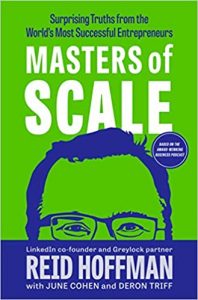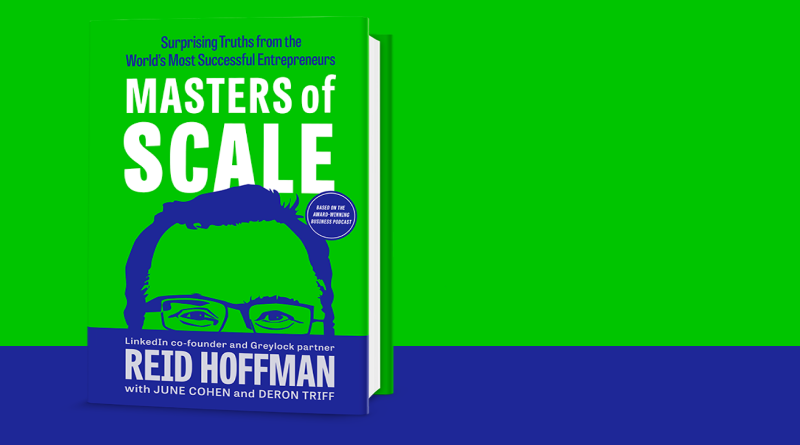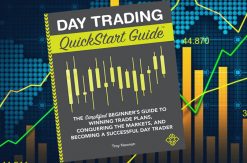Masters of Scale: Surprising Truths from the World’s Most Successful Entrepreneurs by Reid Hoffman, June Cohen & Deron Triff
About the Book:

What can you learn from a Silicon Valley legend and a pantheon of iconic leaders? The key to scaling a successful business isn’t talent, network, or strategy. It’s an entrepreneurial mindset — and that mindset can be cultivated.
Behind the scenes in Silicon Valley, Reid Hoffman (founder of LinkedIn, investor at Greylock) is a sought-after adviser to heads of companies and heads of state. On each episode of his podcast, Masters of Scale, he sits down with a guest from an all-star list of visionary founders and leaders, digging into the surprising strategies that power their company’s growth.
In this book, he draws on their most riveting, revealing stories — as well as his own experience as a founder and investor — to distill the secrets behind the most extraordinary success stories of our times. Here, Hoffman teams up with Masters of Scale’s executive producers to offer a rare window into the entrepreneurial mind, sharing hard-won wisdom from leaders of iconic companies (including Apple, Nike, Netflix, Spotify, Starbucks, Google, Instagram, and Microsoft) as well as the bold, disruptive startups (such as 23andMe, TaskRabbit, Black List, and Walker & Co.) that are solving the problems of the twenty-first century.
Through vivid storytelling and incisive analysis, Masters of Scale distills their collective insights into a set of counterintuitive principles that anyone can use. How do you find a winning idea and turn it into a scalable venture? What can you learn from a “squirmy no”? When should you stop listening to your customers? Which fires should you put out right away, and which should you let burn? And can you really make money while making the world a better place? (Answer: Yes. But you have to keep your profits and values aligned.) Based on more than a hundred interviews and including a wealth of new material never aired on the podcast, this unique insider’s guide will inspire you to reimagine how you do business today.
Amazon Link to purchase Hardcover and Paperback.
Editorial Review:

“[Hoffman] seizes on traits that might otherwise be missed . . . [and] earnestly contends that, through careful attention to leadership and culture, the propulsive drive to grow can be disentangled from the toxic behavior so often associated with explosive expansion. It feels like the triumph of hope over experience.”
—The Wall Street Journal
“Whether you’re at a startup or working to drive change within a large organization, the business principles in this book will help you deploy your strategy with creativity, integrity, and realism.”
—Satya Nadella, CEO, Microsoft Corporation
“Think of this book as mentorship in ten chapters, with stories and advice from people you might already admire, as well as people whose journeys are just starting. You’ll come away with at least a couple of new mantras and a new understanding of the how and why of building your business.”
—Franklin Leonard, founder of The Black List
“Reid Hoffman has a talent for getting right to the heart of a business case and turning it into an unforgettable lesson. If you’re scaling a company—or if you just love a well-told story—this is a book to savor.”
—Bob Iger, executive chairman, The Walt Disney Company
About The Author:
Reid Hoffman An accomplished entrepreneur, executive, and investor, Reid Hoffman have played an integral role in building many of today’s leading consumer technology businesses, including LinkedIn and PayPal. He possesses a unique understanding of consumer behavior and the dynamics of viral businesses, as well as deep experience in driving companies from the earliest stages through periods of explosive, “blitzscale” growth. Ranging from LinkedIn to PayPal, from Airbnb to Convoy to Facebook, Reid invests in businesses with network effects and collaborates on building their product ecosystems. Reid co-founded LinkedIn, the world’s largest professional networking service, in 2003.
LinkedIn is thriving with more than 500 million members around the world and a diversified revenue model that includes subscriptions, advertising, and software licensing. He led LinkedIn through its first four years and to profitability as Chief Executive Officer. In 2016 LinkedIn was acquired by Microsoft, and Reid became a board member of Microsoft. Prior to LinkedIn, Reid served as executive vice president at PayPal, where he was also a founding board member.
Reid joined Greylock Partners in 2009. He focuses on building products that can reach hundreds of millions of participants and businesses that have network effects. He currently serves on the boards of Airbnb, Coda, Convoy, Edmodo, Entrepreneur First, Gixo, Microsoft, Nauto, Xapo, and a few early-stage companies still in stealth. In addition, he serves on a number of not-for-profit boards, including Kiva, Endeavor, CZI Biohub, and Do Something.
Prior to joining Greylock, he angel invested in many influential Internet companies, including Facebook, Flickr, Last.FM, and Zynga. Reid is the co-author of two New York Times best-selling books: The Start-up of You and The Alliance. His next book is focused on “blitzscaling”, based on his Stanford course of the same name. Reid is the host of Masters of Scale, an original podcast series and the first American media program to commit to a 50-50 gender balance for featured guests. Reid earned a master’s degree in philosophy from Oxford University, where he was a Marshall Scholar and a bachelor’s degree with distinction in symbolic systems from Stanford University.
In 2010 he was the recipient of an SD Forum Visionary Award and named a Henry Crown Fellow by The Aspen Institute. In 2012, he was honored by the Martin Luther King Center’s Salute to Greatness Award. Also in 2012, he received the David Packard Medal of Achievement from TechAmerica and an honorary doctor of law from Babson University. In 2017, Reid was appointed as a CBE by her majesty Queen Elizabeth II.
June Cohen is an American producer and entrepreneur. She is currently the CEO of WaitWhat, a media company she co-founded with Deron Triff. WaitWhat creates the podcasts Masters of Scale with Reid Hoffman, Should This Exist? Meditative Story, and Spark & Fire.
Deron Triff is co-producer of the Masters of Scale podcast. Prior to that, he served on the executive team at TED where he built nearly 100 partnerships that grew the brand’s audience to over 100 million per month. He previously served as Vice President of Digital Ventures for PBS.
My Review:
Appearance:
Content:
Did You Know: (Book Articles)
Watch What They Do, Not What They Say
It was early days at Google, long before Google Docs or Google Maps or Gmail made their way onto the world’s screens. The company’s founding team had just launched their fledgling search engine, and they were singularly, obsessively focused on what they called “excellence in search.” The problem was, they didn’t know what “excellence in search” actually looked like.
Their home page was brilliantly simple—just a search box and two buttons, one of which said, “I’m feeling lucky.” It was a radical departure from cluttered portals like Yahoo! that was popular at the time. The search results page was just as a contrarian. No ads. No news headlines. Just really good search results. But how many should they have? And what should they look like?
Co-founder Larry Page wanted Google’s design to be based on objective data, rather than subjective design sensibilities. So he had his engineers build something they called the “experiment framework.” Marissa Mayer, a key engineer on the Google Search team, implemented the first of these experiments, designed to determine the ideal number of search results to display after a user typed in a query. As a first step, Marissa surveyed users, asking how many search results they wanted to see per page. Was it twenty? Twenty-five? The answer was thirty. Users’ feedback was clear: The more results you showed people per page the better. Based on what people said, at least.
But something unexpected happened during the next test when they watched how users actually behaved. Google deployed different versions of the search results page, each identical except showing a different number of results, and counted: How many searches did a user perform? How many pages deep did they go? And how many users abandoned the site altogether?
It became clear that in reality, less was actually more. The magic number was ten results per page, rather than the thirty the survey data had indicated. “When we looked at first-page search results requested per user,” Marissa says, “it fell off dramatically between ten and twenty; twenty-five was even worse; thirty was worst of all.”
What accounted for this dramatic gap between users’ perceptions and their actions? It turned out more results per page came at a cost—one that was extremely important to users, even if they didn’t realize it consciously: speed. A page with twenty or thirty results loaded more slowly than a page with ten. The difference in load time was barely perceptible, but the impact was undeniable. “Time matters a lot more to people than they usually articulate,” Marissa said.
“Waiting for that split second longer for more results was something people didn’t want to do—especially since the first ten results were generally good enough.” This discovery had a huge impact on Google—it was a formative lesson not only on the specific question “How many search results per page do users want?” and on the primacy of speed, but also on the process of truly understanding user feedback. Surveys are great when you need to understand nuanced sentiment and feelings. But if you want to understand what your users will actually do, you need to watch them do things.
To watch what they do—watch the data
There comes a point in every founder’s journey where they need to take a terrifying step: giving someone else the login details for the company inbox. To get to scale, founders need to find systematic ways to understand customer data, beyond their own direct observations and gut reactions. As the event platform, Eventbrite grew, co-founder Julia Hartz had to move on from reading every single piece of customer mail herself.
She now had teams of engineers and customer support staff to scour the usage data and search-engine traffic, while customer support staff reported back on the emails they received. Julia’s new role here? Constantly finding new ways to process all that feedback. One of her techniques is a standing meeting called Hearts to Hartz, bringing together a cross-section of Eventbrite staff, including both data analysts and the support team who actually talk to customers. “To watch them connect, and to watch how their experiences could converge, was pretty fascinating,” Julia says.
“It was like this manifestation of vision and true empathy for the customer, coupled with what the data is telling us.” You can think of this pairing like one of the vital relationships in Star Trek: The data is your Mr. Spock, detached and logical. And customer empathy is your Dr. McCoy, passionate and all too human.
To get the best out of each, you need to bring them together. “I actually think the data insights team we have has in a way benefited from not talking to customers all day,” says Julia, “because they are actually looking at just the data.” The data team could see what people do—rather than what they say they’ll do. But the data picture is incomplete until you understand why. “Which is where the customer support team comes in,” Julia says. “And then looping that together with folks who are really creating that human connection— bringing all of that together creates this matrix picture of where we’re seeing heat and light.”
This matrix is an essential—and available—tool for any company. When you combine data and empathy, you can see the bigger picture of what your customers want and need. Not just in the present, but in the future.
The Trojan Horse
Howard Schultz grew up in public housing in the neighborhood of Canarsie, on the eastern shore of Brooklyn. Howard’s father was a World War II veteran who didn’t experience the American dream he thought he was coming home to after the war. Howard’s father returned home with yellow fever and struggled to make ends meet.
The economy was booming in postwar America, but as a high school dropout, he didn’t have a lot of options. The worst in his series of dead-end jobs was as a delivery driver picking up and delivering cloth diapers. During one delivery, he slipped on a sheet of ice and fractured his ankle, and broke his hip. The injury got him fired.
No workman’s compensation, no health insurance, no safety net. “When I was seven years old I came home from school, opened the apartment door, and saw my father laid out on a couch with a cast from his hip to his ankle,” Howard says. “At the age of seven, how could I possibly understand the impact that would have on me? But I know it scared me to witness the hard time my parents went through. It sensitized me to people living on the other side of the tracks.” Years later, at his own company, Starbucks, Howard tried to build “the kind of company my father never got a chance to work for. A company that would try to balance profit with a conscience.” Howard began thinking about how to maintain this delicate balance from the earliest days in his career.
In 1986, Howard was living in Seattle, and working for the original Starbucks—a relatively small, local operation with just a handful of stores. But a fateful business trip to Milan gave him a bigger idea of the role coffee could play in people’s lives. “I became enamored with the fact that on every street there were two or three coffee bars.
What I witnessed was the romance, the theater, and the joy of espresso. “I would go back to these coffee bars every day I was in Italy, and I began to witness something: I would see the same people who were doing this routinely. They didn’t know each other, but there was a camaraderie between them because there was a sense of place, a sense of community, and there was human connection over coffee.” Howard returned to Seattle, left Starbucks, and founded his own upstart company, with several Milan-style coffee bars. Meanwhile, the original Starbucks acquired Peet’s Coffee, based in Berkeley, California.
The overextended owners realized they had bitten off more than they could chew— and decided to sell Starbucks. They gave Howard first dibs. Howard was able to attract investors with his vision of a new kind of coffee shop and raised the money to acquire Starbucks—then six stores and an old roasting facility—for the modest sum of $3.8 million. By the end of 1987, he had eleven stores, one hundred employees, and a dream of expanding the “theater and romance” of Italian coffee culture nationwide. But before undertaking this next wave of early expansion, he had another priority in mind:
He started planning a benefits package for those one hundred employees. For Howard’s private investors, learning of this plan was just the first of many befuddling encounters. “You can imagine this conversation,” says Howard. “We were small, losing money, with a not-yet-proven business model. And I say, ‘I want to provide health insurance and equity in the form of stock options for every person who works for the company.’ ” They thought this decision was, shall we say, misguided.
But Howard laid out the business case for conscience: “I want to invest in our people,” he said, “and I think I will be able to prove that we will lower attrition, raise performance, but most importantly create the kind of company in which people feel part of something larger than themselves.”
I always write my reviews on Amazon, 3ee, Goodreads, LibraryThing, and Social Media such as Facebook, Instagram, Twitter, Linked In, Telegram.
If you also have read this book, please share your review below, we greatly appreciate your comment, and let’s talk about it!




September 21, 2021
[…] Masters of Scale: Surprising Truths from the World’s Most Successful Entrepreneurs […]
September 22, 2021
[…] Masters of Scale: Surprising Truths from the World’s Most Successful Entrepreneurs […]
September 22, 2021
[…] Masters of Scale: Surprising Truths from the World’s Most Successful Entrepreneurs […]
September 22, 2021
[…] Masters of Scale: Surprising Truths from the World’s Most Successful Entrepreneurs […]
September 25, 2021
[…] Masters of Scale: Surprising Truths from the World’s Most Successful Entrepreneurs […]
September 26, 2021
[…] Masters of Scale: Surprising Truths from the World’s Most Successful Entrepreneurs […]